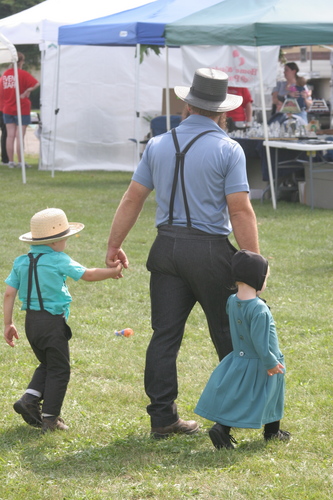Heck, the people behind the government health care plan think 25 should be the earliest age for adulthood.
But as the pampered Generation X gave birth to their more pampered descendants, we discovered that a lot more kids have health problems. All that antibacterial soap and hand washing and unwillingness to let kids get dirty is damaging the immune system in a way that anti-science kooks in Europe only dream could happen due to genetically modified potatoes.
One demographic has escaped this issue, though; Amish kids.
"In the general population as many as 50 percent will have evidence of allergic sensitivity," says Dr. Mark Holbreich, an allergist with Allergy and Asthma Consultants. In Amish kids? 7 percent. About what I grew up with in the general population. All kinds of kids have peanut allergies now, for example, but I did not know a single child with a peanut allergy, living in both metropolitan Florida and rural Pennsylvania. It's called the hygiene hypothesis and it suggests city kids with the wealthiest, most caring parents are actually receiving some harm from being too clean.
At the annual meeting of the American Academy of Allergy, Asthma and Immunology (AAAAI) in Orlando, Holbreich presented results from 29,000 questionnaires to Swiss families of children between the ages of 6 and 12 years old. They did allergy testing for a random sample and 138 Amish children were tested while 3,006 non-Amish farm kids were tested along with 10,912 non-farm children. Farm children had much lower rates of allergies than other kids (city, etc.) while the Amish were substantially lower even than farm children. Asthma instances followed the same pattern.

Nice people, and if you are ever in north central Pennsylvania, buy some butter from them. Wonderful stuff. It turns out they also might be a stronger force in future evolution, because they get sick a lot less than other kids. Photo: Shutterstock
Eating a little dirt can be healthier than never doing anything at all. I've told the story before about my last job working for someone else. My applications engineer in Taiwan took me on a walking tour of Hsinchu and bought me some delicious spiced chicken from a street vendor. He bought me two because he was a big guy and assumed I would want two also.
I returned to my hotel room and the CEO, my boss and something of a semiconductor legend, had an email waiting for me with a wealth of information about the foundries there, Hsinchu in general, and then 300 words down, "Whatever you do, don't buy chicken out on the street." Hepatitis is everywhere and they're all immune to it, he noted, but Americans need vaccines, he wrote.
Well, I didn't know a lot about hepatitis and I was eating that second chicken when I read his email. When I returned home a week later I went to a doctor who did a test and said I didn't get hepatitis nor would I, I was immune - at least not the kind you might from eating chicken on the street in Taiwan. I was curious why, since many Americans needed shots, and he asked if I ever lived on a farm. Well, I had and he explained that on a farm, around animals, etc., minor exposure to hepatitis happened so often (like due to animal poop) an immunity was built up early.
No one is claiming you should become Amish or run out and drink raw milk. In health, you can disregard the needlessly risky and pasteurization has proven its worth. Plus, it would take me forever to get to the baseball game in a horse and buggy. But those antibacterial soaps and the triclosan in them have to go. And let kids get dirty.
Citation: M. Holbreich, J. Genuneit, J. Weber, C. Braun-Fahrlander, et al., 'The Prevalence of Asthma, Hay Fever and Allergic Sensitization in Amish Children', Journal of Allergy and Clinical Immunology Vol. 129, Issue 2, Supplement, Page AB130 doi:10.1016/j.jaci.2011.12.433




Comments